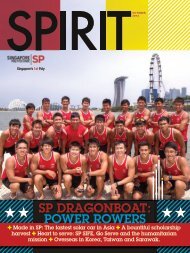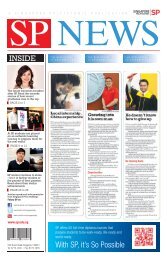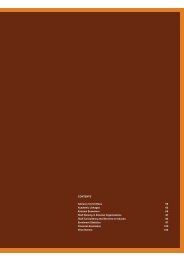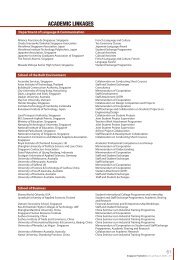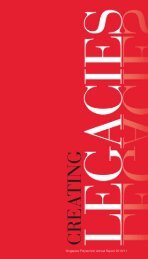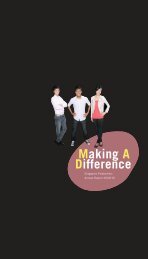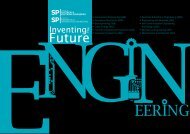SYNOPSES - Singapore Polytechnic
SYNOPSES - Singapore Polytechnic
SYNOPSES - Singapore Polytechnic
You also want an ePaper? Increase the reach of your titles
YUMPU automatically turns print PDFs into web optimized ePapers that Google loves.
<strong>SYNOPSES</strong>SD107ZTheory of Design IIExamines Western architectural intentions andthe development of parallel critical thoughtfrom the early treatises right up to the 20thcentury. Students are also introduced tophilosophical ideas related to the relevance ofethical and poetic making of design. Studentsare required to study built and theoreticalworks of major architects and designers usingcase studies as part of their research for thedesign project. Students would articulate theirvarious studies in seminars, writings and in thepresentation of their design projectSD108ZDesign Studio IIIExamines the issues and challenges ofinterior design within the context of civic andcultural environment such as work-spheres,restaurants, library, galleries etc. Thisespecially as a response to the demandsof a highly global and technological world.Students demonstrate their knowledgeand skills in their final-year designs fromconceptualisation to documentationfor construction.SD109ZInterior Technology IIIThis module further develops the knowledgeand skills of using materials and detailingtechniques in interior design to respond tothe complexities of new architectural designsand technologies. At the same time, studentsare also exposed to the importance ofenvironment management and sustainabilityand they learn to refine their design anddetailing skills. The advancement in lightingtechnology is studied and students learn theirimportant effects on interior design. Therelevant building codes and standards are alsointroduced when students are applying theirknowledge in their design project.SD110ZTheory of Design IIIExamines issues in modern and post-modernexpressions in art, architecture, design andphilosophies. Students also study worksof contemporary architects, designers andthinkers, who have contributed to the critiqueof design theories and practice. They arerequired to reflect their studies and expresstheir thought in writings and design oftheir project.SD111ZProductivity &Quality Management inInterior Design PracticeThis module provides practice-orientedinterior design training that developsstudents with the relevant discipline, skillsand knowledge to apply into their projects.Students are exposed to productivity conceptand applications with emphasis on theoperations and functions of interior designpractice. Pre- and post-contract administrationprocedures are also introduced to students forthe understanding of the quality managementexpected in an interior design office.SD201ZVisual Design StudioIntroduces the function of various designelements, and identifies how the principlesof design influence the creative processesinvolved in design decisions. Through theanalysis of solutions to communicationsproblems, students will explore crucial designperspectives in the following topics:• Visual Design offers a basic disciplined,systematic approach to conceptdevelopment applied to graphic design.Students will learn the function ofvarious design elements, and identifyhow the principles of design influenceeach decision they make when creatinga design. They will explore the creativeprocess of making images that can moveideas and information to the minds of anaudience. Abstraction, imagery,layout, and sequencing are studiedthrough assignments and critiques.• Digital Imaging aims to provide studentswith the basic knowledge of techniquesand tools for illustration and imageprocessing in graphic design. Studentswill learn the techniques in imageprocessing for graphic design. This topicwill cover the techniques of computerbased illustration. In addition, studentswill be trained on the use of imageprocessing and illustration tools forgraphic design.• Typography will introduce the basicconcepts and anatomy of good type,the principles of typographic design andtypesetting. Students will learn thetechniques for working with typefundamentals and to use type effectivelyas a basic element of graphiccommunication. Projects allow studentsto explore issues of form and meaning,hierarchy, legibility and readability,structure and composition, and thedesign process.• Colour and Communication introducescrucial topics like colour theory, colourperception, colour matching, colourmodels and colour design considerations.Beginning with a perceptualunderstanding of colour, this topic willguide students in exploring the manyways that colour communicates. Studentswill study how light modulates ourperception of volume and colour. Theywill learn to employ a variety of mediato explore sensory and emotional, as wellas aesthetic concepts.• Introduction to Photography focuses onthe use of Photography as a multipurposedesign tool. The basic technicalskills cover the operation of the camera,indoor and outdoor shooting. Lessonsinclude discussions, slide shows, andvisits to photography exhibitions.Major emphasis is placed on thelanguage of the photographicmedium and how it communicatesgraphic information. By the end of themodule, students would have embarkedon an integrated design project that fullyincorporates and applies their knowledgegained in this module.SD202ZDesign Thinking 1Aims to equip with a robust toolkit ofcreativity techniques and innovation-focusedresources for their personal and professionallives. This module will consider the centralrole of human cognition and creativity inthe design process, exploring the designerresponse to human needs and issues ofvalue, and the thinking strategies requiredfor achieving breakthrough designs. Themodule introduces the basic principles andmethods for assembling, developing, andanalysing information in the task of design,and discusses the scope of design in ourpersonal, social, and cultural environment,observing how thoroughly design haspermeated our lives through images,physical objects, services, and environmentalsystems, and what implications this has onthe design process. Techniques of creativeideation and innovation are discussed andpractised through the use of visual materials,workshops, group activities, case studies,discussions, critique and presentations.SD203ZDrawing StudioProvides students with the opportunity towork with a variety of drawing media such ascharcoal, ink, oil pastel to develop line, shapeand tone to arrive at an integrated image.Through drawing exercises that cover areaslike texture and volume, space relationships,316 <strong>Singapore</strong> <strong>Polytechnic</strong> Prospectus 2008/2009




